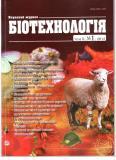ISSN 1995-5537

"Biotechnology" journal V. 5, No. 1, 2012
Р. 107-114, Bibliography 16, Ukrainian.
Universal Decimal classification: 577.152.321+663.11
Donetsk National University
Selection of the cultivation conditions for basidiomycetes which are active producers of cellulolytic enzymes was particular in initial pH of nutrient medium (the factor ranged 1 pH apart from 3 to 9 pH) and cultivation temperature (the factor ranged 2 0С apart from 24 to 36 0С). We determined the overall cellulolytic activity of all enzymes cellulase complex towards filter paper. It was determined that optimal initial pH of the nutrient medium for all strains was equal 7, and cultivation temperature was 28 0С for strain Sh-1 Stereum hirsutum, 32 0С for strain AnSc-1 Daedaleopsis confragosa f. confragosa and 34 0С for strains К-1, А-Дон-02, Д-1 Irpex lacteus. As a result of optimization the values of total cellulolytic activity increased by 16% for strain К-1 Irpex lacteus, 19% for strain А-Дон-02 Irpex lacteus, 107% for strain Sh-1 Stereum hirsutum and 159% for strain Д-1 Irpex lacteus. At the same time, as a result of selection of cultivation conditions specific cellulolytic activity of strain Sh-1 S. hirsutum increased by 9%, А-Дон-02 I. lacteus — by 23%, AnSc-1 D. confragosa f. confragosa — by 51% and Д-1 I. lacteus — by 143%. In strain J-2An phellinus pomaceus cellulase activity was not found.in any variant of the experiment. Maximal total cellulolytic activity of enzymes was found in cultural liquids for К-1, А-Дон-02, Д-1 Irpex lacteus and AnSc-1 D. confragosa f. on the 7th day of the experiment, while Sh-1 S. hirsutum — on the 14th day.
Key words: basidiomycetes, cellulolytic enzymes, cultivation temperature, acidity of nutrient medium, optimization, Irpex lacteus, Stereum hirsutum, Daedaleopsis confragosa f. confragosa, Phellinus pomaceus.
© Palladin Institute of Biochemistry of National Academy of Sciences of Ukraine, 2008

